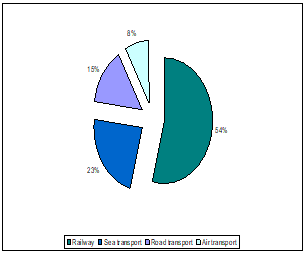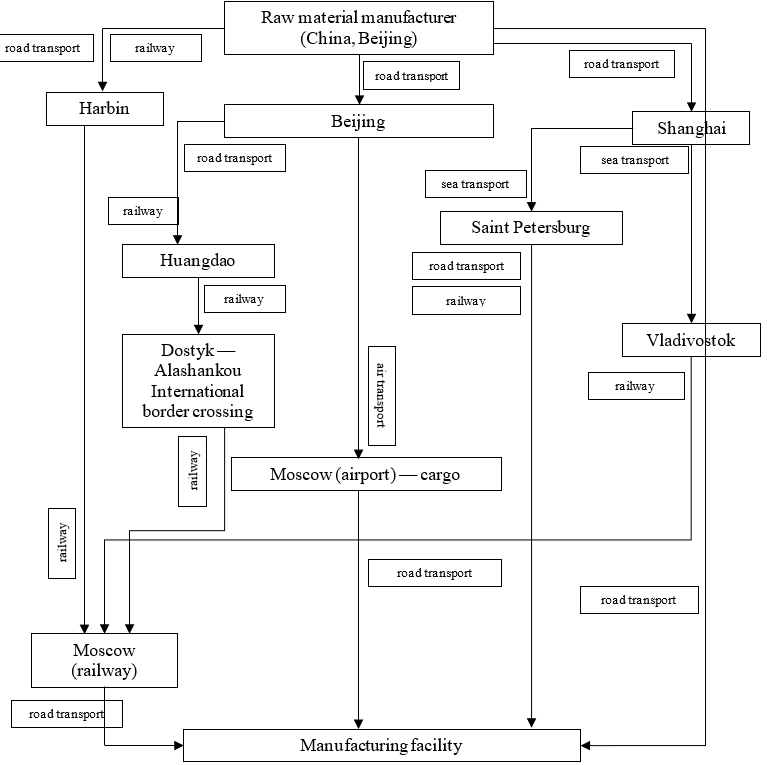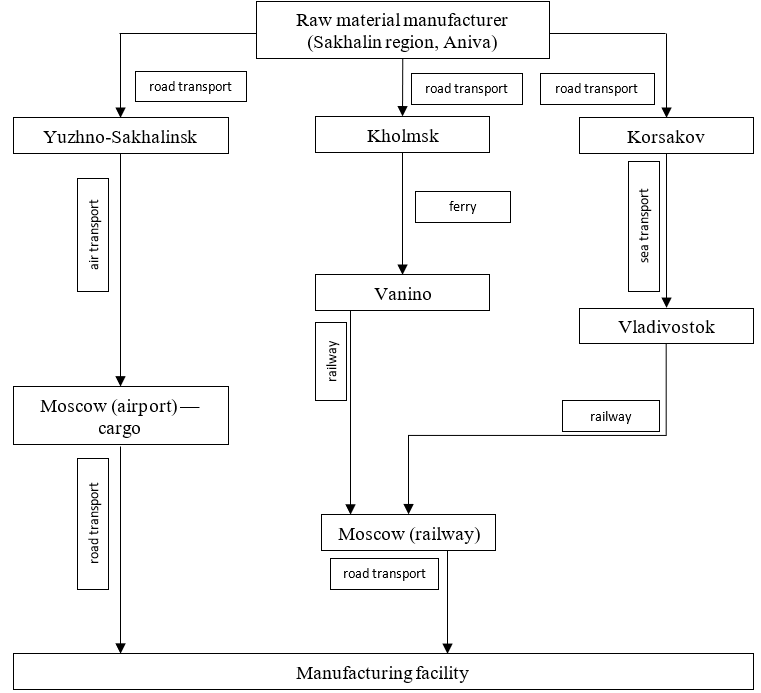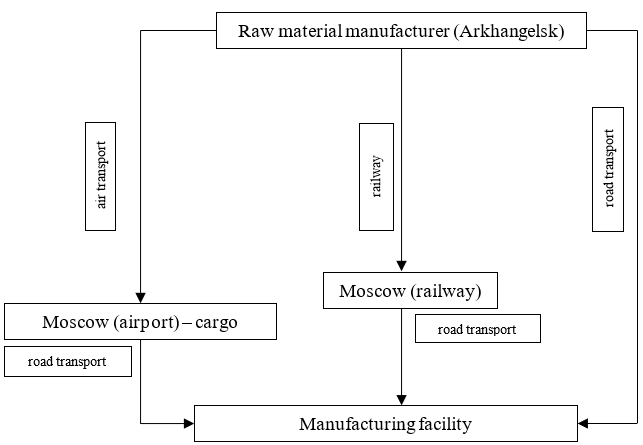Supply Chain of Laminaria Herbal Substances for the Pharmaceutical Industry of the Russian Federation
T.M. Litvinova*, I.U. Glazkova, A.A. Sinitsyna, D.A. Ermakov, G.V. Nesterov
Sechenov First Moscow State Medical University, 8 Trubetskaya St., bldg. 2, Moscow, 119991, Russian Federation.
ABSTRACT
This study examined the supply chain of kelp thallus medicinal herbal substance for the pharmaceutical industry of the Russian Federation (from Arkhangelsk and Sakhalin), as well as the territory of China. Based on the systemic research method and the information and analytical method, various block diagrams of supply chains of kelp thallus herbal substances were developed and proposed for industrial use, considering the relevant risks. The authors have considered the existing routes for the delivery of raw materials through both the territory of Russia and China and analyzed delivery by various types of transport. Based on the data obtained, it was revealed that various types of transport such as rail, road, sea, and air transports can be used to deliver raw materials. The authors analyzed the shares of different types of transport in cargo transportation from China to the Russian Federation. The optimal way to deliver sugar kelp to the production plants located in Arkhangelsk, Moscow is rail transportation. Considering the unloading of the train and delivery to the manufacturer's warehouse, delivery takes no more than a day. In the case of delivery from Sakhalin, the goods have to be transported by expensive air transport. Although the delivery of kelp thallus raw materials from China takes relatively longer in the case of using air transport or is more expensive in the case of rail transport, in less than a year, kelp raw materials with a total value of $16.7 million were imported from China. In 2018, the share of China's imports amounted to 57.7%, and the growth in the value of exports amounted to 27%.
Keywords: supply chain, medicinal herbal substance, sugar kelp, Laminaria saccharina (L.), Japanese sea tangle, Laminaria japonica Aresch.
Introduction
Diseases caused by iodine deficiency are a serious problem in many countries of the world [1, 2]. According to UNICEF, iodine deficiency diseases (IDDs) are the most common non-communicable diseases [3]. 80% of the territory of the Russian Federation is located in the iodine deficiency zone [4]. Timely correction of iodine deficiency with the help of pharmaceutical products (PPs) or dietary supplements (DSs) containing iodine or food enriched with iodine [5-8] can reduce the incidence of thyroid diseases and congenital malformations, as well as reduce the lag of children in physical and mental development [9-11].
The effectiveness of preventive measures is largely determined by their availability. The use of kelp is one of the most affordable ways to reduce the incidence of IDDs. The concentration of iodine [9, 12] in kelp varies depending on its type and collection period and is in the range of 50-700 μg of iodine/100 g [13]. Kelp thallus also contains vitamins (B1, B2, B12, A, C, D, E, carotenoids), polysaccharides (laminarin, mannitol, fructose) [14-19], salts of potassium, sodium, magnesium, bromine, cobalt, iron, manganese, sulfur, and phosphorus compounds [20, 21]. Kelp raw material has a laxative effect [22-24], due to the ability to swell and increase in volume, it irritates receptors in the intestinal mucosa.
The segment of PPs for the prevention of IDDs includes monopreparations containing potassium iodide (Iodomarin, Iodbalans 100) and multivitamin complexes with an iodine-containing component (Vitrum, Multi-tabs). As an additional source of iodine, it is recommended to take DSs with food (such as Iod-active, Laminaria). Kelp thallus is also produced in the form of crushed herbal substance (Krasnogorskleksredstva JSC, Firma Zdorovye LLC, Fitofarm LLC) [25]. Both Firma Zdorovye LLC and Fitofarm LLC buy raw materials harvested in Russia, while Krasnogorskleksredstva JSC imports raw materials from China.
For the prevention of IDDs, specialized food products produced using kelp are recommended [26-28].
Kelp is also used in the cosmetics industry [29, 30], kelp thalli are found in cosmetic wraps, kelp powder is used to prepare wrapping masks, infusion for baths or compresses, and kelp liquid extract is added to phyto barrels or used in scrubs.
According to the Federal State Statistics Service, from 2010 to 2016, about 3.5 thousand tons of kelp per year were harvested in Russia on average.
The main suppliers of kelp to Russia are China and Korea. In 2018, the share of China's imports amounted to 57.7%, while the Korean share equaled 37.2%, according to the Exporters of Russia unified information portal. At the same time, the growth in the value of export supplies from these countries amounted to 27% and 31%, respectively. In the first ten months of 2018, Russia imported $16.7 million worth of kelp, which was 30% more than the volume of imports of this product for the full 2017 ($12.8 million).
The relevance of this study is related to the quarantine measures for the COVID-19. Many logistic systems have been interrupted or undergone significant changes due to the epidemiological requirements of both supplier countries and consumer countries. China remains one of the main suppliers of herbal substances (MHS) for the pharmaceutical industry. However, in the light of new epidemiological requirements and restrictions in the world, due to the pandemic, we are forced to develop other logistics supply chains.
Methods
Based on the information and analytical, as well as systemic methods, we developed and proposed a supply chain for the delivery of kelp thallus MHS for the pharmaceutical industry of the Russian Federation. The information and analytical methods are based on the selection of information, including the processing of the information received, the establishment of the relationship between facts, the identification of the meaning of these relationships, and the development of specific proposals based on reliable and complete, analytically processed information. The systemic method is based on the consideration of an integral object in the totality of relations and connections between many of its elements. In determining the risks, we used the Five Whys method. In the course of this analysis, to determine the cause of the failure (risk), we repeatedly asked the same question — Why? Typically, the question is asked five times; however, there can be more or fewer repetitions. In general, the question is asked until the answer remains unchanged or is out of one's span of control. The Five Whys analysis makes it easier to identify the true causes of risks or failures.
Results and Discussion
1) In China, both wild and cultivated Japanese sea tangles are harvested along the east coast of Liaoning province in the north to Fujian province in the south.
Cargo transportation from China to Russia is carried out by various types of transport [31-33]: road, rail, sea, and air transports (Fig. 1).

Figure 1: The share of different types of transport in cargo transportation from China to the Russian Federation [34]
Cargo transportation by air is the fastest delivery method taking 4 to 5 days, considering export clearance in Beijing, flight time, and customs clearance in Moscow [35]. The cost of a kg of MHS with this delivery method varies from $3.2 to 3.5.
Cargo transportation from China to Moscow by road will take from 10 to 14 days. However, this method is only in demand when transporting goods from China to the cities that are close to the border or do not have a railway connection. Delivery by road to Moscow is economically unprofitable, primarily due to the considerable distance between cities and underdeveloped roads.
The most demanded way of import is railroad transportation. The most popular routes are transportation via the Eurasian Land Bridge [36, 37] and along the Sino-Eastern Railway.
Transportation through the Eurasian Land Bridge is transit and passes through the territory of Kazakhstan (the Alashankou — Dostyk border crossing), after which the route goes along one of two possible trunk connections (Turksib, Astana — Petropavlovsk meridian line), and the other two (Tashkent railway, communication through Atyrau and the Astrakhan region) go directly to the European part of Russia. Delivery time to Moscow takes no more than 23 days, including delivery to the customs terminal of Kazakhstan (up to 14 days) and subsequent delivery to Moscow (no more than 8 days) [38]. The delivery of a kg of cargo will cost an average of $2-2.5.
When transported by the Chinese-Eastern Railway, the cargo enters the north of China, from where it follows the Chinese-Eastern Railway and passes through the Manchuria-Zabaikalsk border crossing. Further on Russian territory, the cargo goes along the Trans-Siberian Railway to Moscow.

Figure 2: Logistic supply chain of kelp thallus MHS from China
The cost of transportation of a kg of raw materials by rail is $ 2-2.5; the duration of transportation is 28 to 35 days.
Delivery by sea transport is no less in demand [39] (ports of Shanghai, Nimbo, etc.). The main ports of destination for the cargo transportation in the Russian Federation are the Far Eastern ports (Vostochny port, Vladivostok, Nakhodka) and Baltic ports (ports of St. Petersburg). Upon arrival at the port of destination, the cargo continues the route by road or rail to the destination points [40].
Delivery from the port of China to the Far Eastern ports takes no more than 10 days. The customs clearance takes from 2 to 7 days, and then, the container goes by rail to Moscow and reaches it in 10 to 12 days. Thus, the total delivery time from Shanghai to Moscow with customs clearance at the port of Vostochny is from 22 to 27 days.
Transportation through the Baltic Sea is also in demand. The delivery time from Shanghai to Moscow via St. Petersburg takes no more than 55 days. A container sail from the port of Shanghai to St. Petersburg for 35 days, then customs clearance takes 7 days, then delivery by road takes 3 to 4 days.
The cost of sea cargo transportation from China to Russia, considering customs clearance, is $0.7-1.1 per 1 kg of raw materials.
2) In Russia, sugar kelp (Laminaria saccharina (L.)) and Japanese sea tangle (Laminaria japonica Aresch) are harvested as raw materials.
Japanese sea tangle grows in the south of the Sea of Japan and the Sea of Okhotsk, forming vast thickets in places with the constant movement of water; it is harvested on Sakhalin.
The two main ways of delivering raw materials from Sakhalin are the railway and the Vanino — Kholmsk ferry crossing or the Vladivostok — Korsakov sea route.

Figure 3: Logistic supply chain of kelp thallus MHS from Sakhalin
In the case of delivery by rail, raw materials are delivered by road to the city of Kholmsk, from where it is transported by ferry to the city of Vanino and later delivered by rail to Moscow. The cost of such delivery will be about 20 rubles per 1 kg of cargo and will take 20 to 30 days.
The second way of delivery is transporting the raw materials by road to the port of Korsakov, then by sea to Vladivostok, and then by rail to Moscow. The delivery period does not exceed 25 days (Fig. 3). The delivery cost is from 15 to 25 rubles per kg of cargo.
Air delivery of Japanese sea tangle from Yuzhno-Sakhalinsk to Moscow is carried out by regular flights of Aeroflot and Transaero airlines. The delivery time does not exceed 2 days. The cost of transporting 1 kg of cargo is 500-600 rubles.
Delivery by road will take 20 to 30 days and will cost from 4500 rubles/m3.
3) The closest kelp to the production located in the Moscow region is sugar kelp; its habitat is the open shores of the White and Kara Seas. This kelp is harvested in Arkhangelsk.
The fastest way of delivery of sugar kelp thallus MHS from Arkhangelsk to Moscow is air transportation. Delivery to production using the road and air transport takes no more than 2 days, and the cost of transporting 1 kg of raw materials does not exceed 300 rubles.
Delivery of raw materials from Arkhangelsk to production facilities is also possible by road. The short distance makes cargo transportation by road from Arkhangelsk to Moscow a convenient and economical way of delivery. The length of this route is approximately 1,258 km, and the travel time is about 23 hours. The cost of cargo transportation of 1 kg of raw materials is 50-100 rubles.
The cost of railway delivery from Arkhangelsk to Moscow is 10-12 rubles per kg of cargo. Delivery takes no more than 24 hours (Fig. 4).

Figure 4: Logistic supply chain of kelp thallus MHS from Arkhangelsk.
Conclusion
For the transportation of both Japanese sea tangle and Sugar Kelp, various types of transport can be used, namely rail, road, sea, and air transports.
- The optimal way of the delivery of sugar kelp harvested in Arkhangelsk to the production located in the Moscow region is delivery by rail. Considering the unloading of the train and delivery to the manufacturer's warehouse, delivery takes no more than a day.
- The fastest and, at the same time, the most expensive method of delivery of Japanese sea tangle is from Sakhalin (by air). The most economical, but also the slowest way is delivery by rail.
- Delivery of raw materials from China takes a relatively long time, in case of using air transport, or, in the case of rail transport, is more expensive.
- Today, despite the high share of imports of kelp, Russia has enough resources to fully meet the demand for raw materials. The production of kelp thallus raw material is rapidly developing and increases the volume of products each year.
Acknowledgments
The publication was prepared with the support of the Russian 5-100 Academic Excellence Project (Sechenov First Moscow State Medical University 5-100 Program).
References
- Ghamri KA, Ghamri RA. Evaluation of Thyroid Dysfunction and Thyroid Antibodies Among Subjects with Gestational and Pre-Gestational Diabetes at King Abdulaziz University Hospital, Jeddah: A Retrospective Analysis (2014-2018). Int. J. Pharm. Res. Allied Sci. 2020;9(1):168-75.
- Al-Maathidy, A., Alzyoud, J.A.M., Al-Dalaen, S., Al-Qtaitat, A. Histological alterations in the Thyroid Follicular cells induced by lead acetate toxicity in adult male albino rats, Int. j. pharm. Phytopharm. Res., 2019;9(5):19-26.
- WHO, UNICEF and ICCIDD. Assessment of iodine deficiency disorders and monitoring their elimination. A guide for programme managers. Geneva, 2008.
- Yarkina MV, Popovicheva NN. Perspektivy primeneniya iodirovannoi pishchevoi dobavki v tekhnologii molochnoi produktsii dlyaresheniya problemy iododefitsita [Prospects for the use of iodized food additives in the manufacture of dairy products for solving the problem of iodine deficiency]. In: Nauka v sovremennom informatsionnom obshchestve Materialy XIV mezhdunarodnoi nauchno-prakticheskoi konferentsii, 2018;1:51-53.
- Flórez-Fernández N, Dolores Torres M, González-Muñoz MJ, Domínguez H. Recovery of bioactive and gelling extracts from edible brown seaweed Laminaria ochroleuca by non-isothermal autohydrolysis. Food chemistry. 2019 Mar 30;277:353-61.
- Delaney A, Frangoudes K, Ii SA. Society and Seaweed: Understanding the Past and Present, In: Seaweed in Health and Disease Prevention. San Diego: Academic Press, 201
- Rengasamy KRR. Bioactive compounds in seaweeds: An overview of their biological properties and safety. Food and Chemical Toxicology 2020 Jan 1;135:111013.
- Mollaeva NR, Alieva AA, Aliev MA, Miroshkina ID, Gammatsaeva LSh, Alibekova BA, Yakhyaeva AB. Iododefitsit i psikhicheskoe zdorove detei v respublike Dagestan [Iodine deficiency and mental health of children in the republic of Dagestan]. Vestnik Dagestanskoi gosudarstvennoi meditsinskoi akademii 2012;1:24-27.
- Bajjouka T, Rochettea S, Lauransa M, Ehrholda A, Hamdib A, Le Niliot P. Multi-approach mapping to help spatial planning and management of the kelp species L. digitata and L. hyperborea: Case study of the Molène Archipelago, Brittany. Journal of Sea Research 2015 Jun;100:2-21.
- Alnahdi HS. The Possible Ameliorative Mechanisms of Curcumin and/or Coenzyme Q10 Against Hyperthyroidism Induced Liver Damage in Rats. Entomol. appl. sci. lett. 2018;5(1):7-16.
- Tadayon T, Raisi Dehkordi Z, Jafarzadeh L. Study of the effect of secondhand smoke exposure on level of maternal thyroid hormones by women’s self-report and urinary cotinine level at delivery. Int. J. Pharm. Phytopharm. Res. 2018;8(5):53-8.
- Roleda MY, Skjermo J, Marfaing H, Jónsdóttir R, Rebours C, Gietl, A, Stengel DB, Nitschke U. Iodine content in bulk biomass of wild-harvested and cultivated edible seaweeds: Inherent variations determine species-specific daily allowable consumption. Food Chemistry 2018 Jul 15;254:333–339.
- Podkorytova AV. Morskie vodorosli-makrofity i travy [Macrophyte algae and herbs]. Moscow: VNIRO, 2005.
- Suna Y, Hou S, Song S, Zhang B, Ai C, Chen X, Liu N. Impact of acidic, water and alkaline extraction on structural features, antioxidant activities of Laminaria japonica polysaccharides. International Journal of Biological Macromolecules 2018; 112: 985-995.
- Padam BS, Chye FY. Seaweed components, properties, and applications. Elsevier, 2020.
- Ganesan AR, Tiwari U, Rajauria G. Seaweed nutraceuticals and their therapeutic role in disease prevention. Food Science and Human Wellness 2019; 3(8): 252–263.
- Reboleira J. Brown Seaweeds, In: Nonvitamin and Nonmineral Nutritional Supplements. San Diego: Academic Press, 2019.
- Mišurcová L, Škrovánková S, Samek D, Ambrožová J, Machů L. Health Benefits of Algal Polysaccharides in Human Nutrition. Adv Food Nutr Res 2012;66:75-145.
- Stengel DB, Connan S, Popper ZA. Algal chemodiversity and bioactivity: Sources of natural variability and implications for commercial application. Biotechnology Advances 2011; 5(29): 483–501.
- Gosudarstvennaya farmakopeya Rossiiskoi Federatsii [State Pharmacopoeia of the Russian Federation]. Moscow, 2015.
- Charoensiddhi S, Conlon MA, Franco MM, Zhang W. The development of seaweed-derived bioactive compounds for use as prebiotics and nutraceuticals using enzyme technologies. Trends in Food Science & Technology 2017;70:20–33.
- Demidova MA, Savchuk IA, Shneur SYa. Otsenka slabitelnoi aktivnosti ekstrakta laminarii yaponskoi sukhogo [Evaluation of the laxative activity of dry Japanese sea tangle extract]. Sovremennye problemy nauki i obrazovaniya 2011;6:311.
- Dmitrieva SN, Ridiger AV, Konysheva EN. Laminariya, kak osnova kosmeticheskogo sredstva [Kelp as the basis of cosmetic products]. Rybnoe khozyaistvo 2014; 5: 110-112.
- Déléris P, Nazih H, Bard JM. Seaweeds in Human Health, In: Seaweed in Health and Disease Prevention. San Diego: Academic Press, 2016.
- Gosudarstvennyi reestr lekarstvennykh sredstv [State Register of Medicines]. Available at: http://www.grls.rosminzdrav.ru/Default.aspx
- Burtseva EI. Razrabotka tekhnologii pechenochno-rastitelnoi kulinarnoi produktsiifunktsionalnogo naznacheniya [Development of technology for hepatic and vegetable culinary products for functional purposes]: a PhD in technical sciences dissertation. Orel: FGBOU VPO State University, 2014.
- Kozhukhova AA. Razrabotka kompleksnoi tekhnologii funktsionalnykh produktov iz laminarii [Development of an integrated technology for functional products from laminaria]: a PhD in technical sciences dissertation. Krasnodar, 2006.
- Kraan S. Seaweed resources, collection, and cultivation with respect to sustainability. Elsevier, 2020.
- Couteau C, Coiffard L. Seaweed Application in Cosmetics, In: Seaweed in Health and Disease Prevention. San Diego: Academic Press, 2016. 423-441
- Wang HMD. Exploring the potential of using algae in cosmetics. Bioresource Technology 2015; 184: 355–362.
- Nerush YuM, Panov SA, Nerush AYu. Proektirovanie logisticheskikh system: Uchebnik i praktikum dlya bakalavriata i magistratury. Akademicheskii kurs [Logistics system design: a manual and practical course for bachelor's and master's degrees. Academic course]. Moscow: Yurait, 2016. 6-8.
- Vilarinho A, Liboni LB, Siegler J. Challenges and opportunities for the development of river logistics as a sustainable alternative: a systematic review. Transportation Research Procedia 2019;39:576–586.
- Malle S. Russia and China in the 21st century. Moving towards cooperative behaviour. Journal of Eurasian Studies 2017; 2(8): 136–150.
- Samuilov VM, Druzhinina DN, Tsyao T, Kargapoltseva TA. Osnovnye tendentsii i perspektivy razvitiya rossiisko-kitaiskikh torgovo-ekonomicheskikh otnoshenii [Main trends and prospects for the development of trade and economic relations between Russia and China]. Innovatsionnyi transport 2018; 2(28): 18-22.
- Trans-LOGISTICS. Kazakhstan, 2013. Available at: http://www.translogistics.kz/#0
- Rodemann H, Templar S. The enablers and inhibitors of intermodal rail freight between Asia and Europe. Journal of Rail Transport Planning & Management 2014; 3(4): 70–86.
- Bersenev A, Chikilevskaya M, Rusinov I. Silk Road Rail Corridors Outlook and Future Perspectives of Development. Procedia Computer Science 2020;167:1080–1087.
- Izbairova AS. O Vybore Marshrutov Dostavki Gruzov Iz Kitaya [On Choosing Cargo Delivery Routes From China]. Trudy Universiteta 2016; 3(64): 86-91.
- Cho H, Lee J. Does transportation size matter for competitiveness in the logistics industry? The cases of maritime and air transportation. The Asian Journal of Shipping and Logistics 2020:1-10. https://doi.org/10.1016/j.ajsl.2020.04.002
- Litvinova TM, Glazkova IU, Levagina SА, Shalyapinа EN, Sheina AG. Supply chain of the imported ginseng medicinal plant materials for the pharmaceutical industry of the Russian federation. Uncertain Supply Chain Management, 2019;8(1): 225-230.
Contact SPER Publications
SPER Publications and
Solutions Pvt. Ltd.
HD - 236,
Near The Shri Ram Millenium School,
Sector 135,
Noida-Greater Noida Expressway,
Noida-201301 [Delhi-NCR] India
